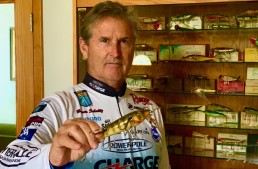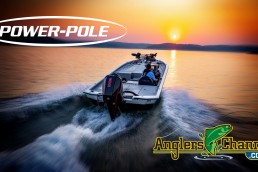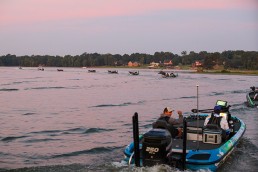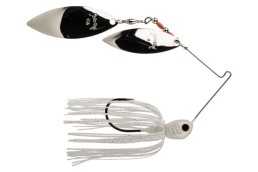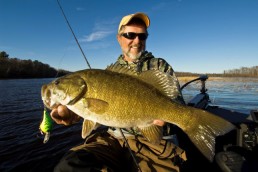Bernie Schultz on Treasured Tackle
Vance McCullough
On a balmy autumn day Bassmaster Elite Series veteran Bernie Schultz and I rode through a wormhole into the past. A classic Old Florida scene played out as we idled by a clapboard shack squatting at water’s edge with its aged gas pump. Painted red letters on the side of the building read: ‘Restaurant’, parts of the word fading or chipped. The antiquated fish camp looked young compared to the grand live oaks that shaded its boat dock, wearing old man beards of Spanish moss.
As we putted through the canal, Bernie spoke of another time machine he’s enjoyed for decades: antique lure and tackle collecting. It’s a thread that binds people together across the years, and across their differences. “I actually started when I was a kid. My grandfather kind of started me. It brings people together from all walks of life, all income brackets, nationalities, all ages. It’s a common interest.
“There’s something about lures. Whether you collect vintage lures or you just fish with contemporary lures, we’re all collectors, in a sense. People that fish love lures. Some of us love old lures. I like the ones that go way back, that kind of defined the sport,” said Schultz who regularly writes a column on antique tackle for Bassmaster Magazine.
While some lures have defined our sport, Schultz notes that the sport of bass fishing has also defined the art of lure-making on an international scale. “A lot of people don’t realize it, but the plug was developed in our country, not in Europe, not in the Orient, it was developed in America for the black bass, primarily.
“Same with your bass reel, baitcasting reel, those originated in America by a Kentucky watch-maker. They understood gearing, they knew how to work with metal and synchronize all those gears and create level winds and all that. Reels existed long before that but not bass casting reels and multiplying reels.”
Schultz warns that a guy can go deep down the rabbit hole of collecting. “I probably spend an inordinate amount of time looking for stuff when I probably should be doing my homework for the lakes I’m fixing to compete on but it’s a passion,” says Schultz, shrugging a bit and making a plaintive gesture with his free hand, the other guiding us steadily on through the canal of time as he orates our passage back through the years. It’s a journey he shares with many. “There’s a lot of guys like me that love it. It’s not a small group; it’s actually international. We have meets. Every year the National Fishing Lure Collectors Club has a national meet and there are regional meets that are sanctioned by them. Then there are smaller organizations like the Florida Antique Tackle Collectors or the Old Reel Collectors Association, ORCA – that’s their acronym. There’s a lot of people out there looking for old tackle and preserving it which, to me, is really important. It’s the history of our sport and the tools of our trade.”
Far from being dusty pieces of memorabilia from a bygone era, many collectible lures still find use. And still catch bass. “You can bet any number of guys on Tour have old Bagley square bills in their boxes. Takahiro Omori, he’s probably the worst,” laughs Schultz. “He’s afflicted big time. His house is full of old square bill crankbaits.
“A lot of guys like the old, early Rapala lures with the foil finish on them. They’re valuable now. Who would have thought that when we were kids throwing them? And go online and look at the auction prices for some of the Storm Wiggle Warts. They’re hundreds of dollars.”
While old lures fetch high prices, Schultz has different motives for chasing antiques. “To me, it’s not about making money with them. There are guys that do that. I know several guys that have made a profession of brokering antique tackle, and they do really well, but I just like ‘em.”

Everything old is new again. Lure design runs in big circles. Every year we see it at the huge ICAST fishing industry trade show where the ‘latest’ innovations are displayed. “There’s not a lot of new ideas in fishing. They’re just perfecting some old ideas, recycling. Case-in-point, would you care to guess when the first hollow belly frog was made?” asks Schultz. I share that I have some from the 1970’s. “Well, you’re about 70 years off. 1895. Not only was it the first hollow belly bait, like the Rojas frogs and the Scum Frog and the Terminator Frog – lot of great frogs out there these days – but it also incorporated weedless hooks. That’s how far advanced that was. In 1895. Think about that. So, there’s not a lot of new ideas.
“The first anti-backlash reel was pre-1900’s. I’m not saying it was effective, but they were thinking about that back in the day. Still working on it. Shimano has got the DC Series, they do a great job of controlling your cast and preventing backlash, but the concept goes way back. We’ve got better materials. We’ve got engineering that’s off the charts. We can put men on the moon. We can build better reels nowadays. But the concept existed before our grandparents were born.”
Given his knowledge of where we’ve been as lure-slingers, you’d expect Schultz, involved in lure design for companies such as Rapala, to incorporate what he’s learned into some new designs. He has. “One thing I learned from the old guys, back when I was a kid, was how to tune props on propeller baits. One thing I learned early on was the importance of counter-rotating props – the front prop going one way and the back prop going the other – and how significant that could be to the action of the lure. The importance of loose hardware, how to cup the blades so they made more commotion when you pull ‘em across the surface. I utilized that knowledge when I helped design the Rapala X-Rap Prop. And you’ve seen that work,” said Schultz remembering a trip on which I watched him smash a couple of big bass by patiently twitching and pausing the lure in place beside a patch of reeds.
Antique prop baits are sought after by collectors. The current iteration is coveted by anglers looking to collect fish. “There’s not a guy on Tour who doesn’t have an X-Rap Prop in his boat. I don’t care who his sponsor is,” notes Schultz. “Any time we’re In Florida, Louisiana, Texas – the Southern States – prop baits are really effective and they’re in demand, especially on tournament day.”
While the problems shared by anglers are as old as the act of fishing and the race to solve those problems is eternal, the artifacts that tell the stories of our progress are fleeting and fragile. “This stuff is disappearing. They don’t make it anymore. There are more and more people, but there’s fewer and fewer old lures and old reels, rods, creels, minnow buckets. It’s important that people know the value of these things.”
If you’re interested in collecting, Schultz advises you to join a club, such as the National Fishing Lure Collectors Club (nflcc.org). “You can learn so much. They have publications that come out periodically, they’ll teach about what’s collectible and what’s not. There’s a lot of counterfeiting going on – anything that has value kind of brings out the worst in some people – they’ll steer you away from the counterfeits. You can find your way through the hobby by joining these clubs, reading the publications. There’s also a number of videos online. And these regional shows I was talking about, if you go to these shows, you’re going to meet people that are knowledgeable and helpful.”
